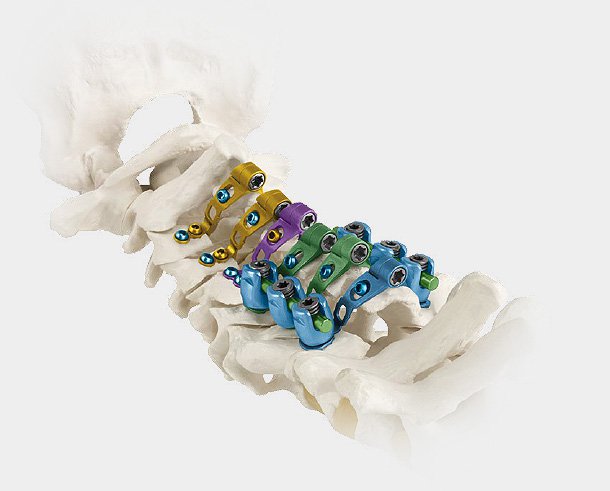Cervical Laminoplasty
What is Cervical Laminoplasty?
A laminoplasty is a surgical procedure that enlarges the spinal canal. A section of bone called the lamina usually forms a rigid “roof” over the spinal canal; a laminoplasty props that “roof” open a little. During a laminoplasty, a hinge is created on one side of the lamina, and the other side is wedged open with a bone strut or a small metallic plate.
Laminoplasty is usually performed in the cervical spine (neck). It may also be performed in the thoracic or lumbar spine (middle or low back), especially in pediatric or younger adult patients.
When is this Procedure Performed?

Cervical laminoplasty is sometimes performed to treat conditions in which a narrowing spinal canal puts pressure on the spinal nerves or spinal cord. This pressure is called compression, and a laminoplasty is a type of decompression surgery–it gives the spinal cord and spinal nerves more room, so that they are no longer compressed.
On the spinal nerves, compression can produce radiculopathy: pain, weakness, or numbness in a single arm or hand.
On the spinal cord, compression is an even more serious problem. Compression can permanently damage the delicate tissues of the spinal cord. Spinal cord compression is called myelopathy, and it may produce weakness, or numbness in both arms or legs, difficulty walking, or impaired bowel or bladder control.
Conditions sometimes treated by decompression with a cervical laminoplasty include:
- ossification of the posterior longitudinal ligament, a condition in which a ligament in the spinal canal becomes thickened and inflexible
- cervical spondylotic myelopathy, degenerative changes that cause myelopathy in the cervical spine
- cervical stenosis, a narrowing of the spinal canal in the cervical spine
A range of surgical options are available for treating these conditions. For example, a similar procedure called a laminectomy removes the lamina instead of hinging it open. Compared to the more extensive laminectomy procedure, a laminoplasty leaves more of the normal bone and ligament structure intact. This can help to maintain normal spinal balance, especially in patients with spinal degeneration.
The laminoplasty also provides a protective layer that prevents scar tissue formation on the dural sac (nerve sac) after surgery. However, since the laminoplasty is less extensive in that it typically removes less bone, it provides less decompression. Individuals who need a greater amount of decompression may be more effectively treated with the full removal of the lamina, a laminectomy.
It is a particularly useful treatment option in some pediatric patients. Pediatric patients are at greater risk than adults for spinal instability following the more extensive bone removal of a laminectomy.
Other surgical options for decompression in the cervical spine include the anterior cervical discectomy or the anterior cervical corpectomy.
Surgeons consider many factors when choosing the appropriate procedure: age and medical condition of the patient, spinal curvature, mobility of the spinal column as measured on flexion/extension X-rays, number of spinal segments involved, location of the major component of spinal cord compression (in front of or behind the spinal cord), and degree of calcification of bone spurs. In general, the most appropriate candidates for cervical laminoplasty are patients with two or more levels of spinal stenosis, normal cervical curvature or a straight cervical spine, no excessive motion on flexion/extension X-rays, and limited or no neck pain.
A cervical laminoplasty may also be performed when a surgeon needs to access the spinal cord for another reason. For example, a cervical laminoplasty can allow access to the spinal cord for the surgical treatment of:
- tumors
- vascular malformations, tangles of abnormal blood vessels
- syringomyelia, fluid-filled cysts within the spinal cord
How is this Procedure Performed?
This surgical procedure is performed under general anesthesia. An incision is made down the middle of the back of the neck, and the back of the spinal column is exposed.
Using an operating microscope and very fine surgical instruments, the surgeon makes a thin cut in the bone at the junction of the lamina and a spinal joint called the facet joint. This cut extends through the outer and middle layers of bone. On the other side of the bone, a similar cut is made that extends through the outer, middle and inner layer of bone. Once both cuts have been made, the lamina is wedged open, immediately opening up the spinal canal and relieving pressure on the spinal cord. The wedged-open portion is kept open with a small metal plate or a piece of bone.
During a laminoplasty, the surgeon may also perform a foraminotomy. This procedure enlarges the foramina, the holes through which nerve roots exit the spinal cord. A foraminotomy can relieve pressure on the nerve roots.
The surgeon will then close the incision and dress it with a bandage.
Contact
FILL IN THE FORM
FOR APPOINTMENT
For Emergency
We Are Open Always 24 hrs | 365 Days
Call: 8657500555 | 8657500666
